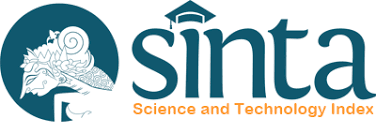Precede-proceed model in determining ultra-processed food consumption patterns among urban young adults
DOI:
https://doi.org/10.22236/argipa.v9i1.13301Keywords:
advertisement, consumption patterns of adolescents, knowledge, peers, ultra-processed foodAbstract
Frequent consumption with large portions of ultra-processed food could increase the risk of death from degenerative diseases, which can be understood through the PRECEDE-PROCEED model theory in determining factors that influence ultra-processed food consumption patterns in adolescents. This research aimed to determine the relationship between knowledge related to ultra-processed food, exposure to food product advertisements, and peer influence with the consumption patterns of ultra-processed food among young adults. The independent variables in this study were knowledge related to ultra-processed food, exposure to food product advertisements, and peer influence, while the dependent variable was the consumption pattern of ultra-processed food. The research method employed was quantitative research with a cross-sectional design. Data were collected through interviews and questionnaire completion from 158 subjects. Sampling was determined using accidental sampling techniques. Data analysis in this study was conducted with bivariate analysis using chi-square statistical tests. The results indicated that 83.5% of the subjects consumed ultra-processed food frequently, with the analysis yielding a p-value of 0.204 for knowledge related to ultra-processed food, a p-value of 0.203 for exposure to food product advertisements, and a p-value of 0.135 for peer influence. It can be concluded that there was no significant difference in proportions between knowledge related to ultra-processed food, exposure to food product advertisements, and peer influence on the consumption pattern of ultra-processed food among university students.
Downloads
References
Afifah, L. P., Suyatno, Aruben, R., & Kartini, A. (2017). Faktor-Faktor yang Berhubungan dengan Konsumsi Fast Food pada Remaja Obesitas di SMA Theresiana 1 Semarang Tahun 2017. Jurnal Kesehatan Masyarakat, 5(4), 706–713.
Ariyana, D., & Astiningsih, N. W. W. (2020). Hubungan Pengetahuan dengan Kebiasaan Konsumsi Makanan Cepat Saji (Fast Food) pada Siswa-Siswi Kelas XI di SMA Negeri Samarinda. Borneo Student Research, 1(3), 1841–1846. https://journals.umkt.ac.id/index.php/bsr/article/download/912/174
Chen, X., Zhang, Z., Yang, H., Qiu, P., Wang, H., Wang, F., Zhao, Q., Fang, J., & Nie, J. (2020). Consumption of ultra-processed foods and health outcomes: A systematic review of epidemiological studies (Consumo de alimentos ultraprocessados e resultados para a saúde: uma revisão sistemática de estudos epidemiológicos). Nutrition Journal, 19(86), 1–10.
Febriyani, M. (2013). Hubungan Daya Tarik Iklan Fast Food pada Media Massa, Asupan Makan, dan Frekuensi Konsumsi Fast Food dengan Kejadian Obesitas pada Remaja di SMA Negeri 3 Pontianak. Universitas Brawijaya.
Glanz, K., Rimer, B. K., & Viswanath, K. (2008). Health Behavior and Health Education (K. GLANZ, B. K. RIMER, & K. VISWANATH (eds.); 4th ed.). Jossey-Bass.
Marrón-Ponce, J. A., Sánchez-Pimienta, T. G., Louzada, M. L. da C., & Batis, C. (2017). Energy Contribution of NOVA Food Groups and Sociodemographic Determinants of Ultra-Processed Food Consumption in The Mexican Population. Public Health Nutrition, 21(1), 87–93. https://doi.org/10.1017/S1368980017002129
Monteiro, C. A., Cannon, G., Lawrence, M., Louzada, M. L. da C., & Machado, P. P. (2019). Ultra-processed Foods, Diet Quality, and Health Using The NOVA Classification System. Food and Agriculture Organization of the United Nations.
Priwahyuni, Y. (2016). Faktor-Faktor Yang Berhubungan dengan Pola Makan Siap Saji (Fast Food) Pada Mahasiswa Program Studi Ilmu Kesehatan Masyarakat STIKES Hangtuah Pekanbaru. Jurnal Ilmu Kesehatan Masyarakat, 5(2), 102–110.
Samingan, & Octaviani, Z. A. (2021). Determinan Perilaku Konsumsi Makanan Siap Saji (Fast Food) pada Siswa di SMA Negeri X Jakarta Timur Tahun 2020. Jurnal Bidang Ilmu Kesehatan, 11(2), 136–145. https://doi.org/10.52643/jbik.v11i2.1829
Santoso, B., & Velania, V. (2017). Hubungan Tingkat Pengetahuan Tentang Makanan Cepat Saji Dengan Pola Konsumsinya Pada Mahasiswa Tingkat II AKPER Panti Kosala Surakarta. KOSALA : Jurnal Ilmu Kesehatan, 5(1), 31–36. https://doi.org/10.37831/jik.v5i1.115
Setyowati, D., Andarwulan, N., & Giriwono, P. E. (2018). Processed and Ultraprocessed Food Consumption Pattern in The Jakarta Individual Food Consumption Survey 2014. Asia Pacific Journal of Clinical Nutrition, 27(4), 840–847. https://search.informit.org/doi/abs/10.3316/ielapa.762174446886472
Vashtianada, A., Setiarini, A., & Sartika, R. A. D. (2023). The Difference of Ultra-Processed Food Consumption Based on Individual Characteristics and other Factors among Non-Health Undergraduate Students in Universitas Indonesia in 2023. Indonesian Journal of Public Health Nutrition, 4(1), 59–71.
Wahyuniar, L., & Karyadi, L. (2020). Pengaruh Iklan Makanan/Minuman/Suplemen Vitamin-Mineral di TV Terhadap Pola Konsumsi Remaja di Wilayah Jakarta Timur. Jurnal Ilmu Kesehatan Bhakti Husada: Health Sciences Journal, 11(1), 95–113. https://doi.org/10.34305/jikbh.v11i1.152
Yetmi, F., Harahap, F. S. D., & Lestari, W. (2021). Analisis Faktor yang Memengaruhi Konsumsi Fast Food pada Siswa di SMA Cerdas Bangsa Kabupaten Deli Serdang Tahun 2020. Jurnal Hasil Penelitian Mahasiswa, 6(1), 25–47.
Downloads
Published
How to Cite
Issue
Section
License
Copyright (c) 2024 ARGIPA (Arsip Gizi dan Pangan)

This work is licensed under a Creative Commons Attribution 4.0 International License.

















